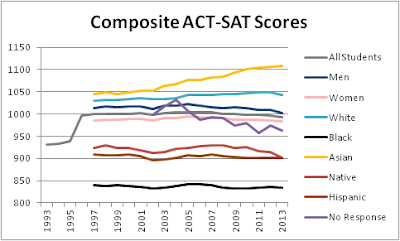The main change in SAT results since scores were boosted by recentering in 1995 is that Asian average scores have been exploding (the upward sloping yellow line above). This has generated a lot of resentment of Tiger Mothers among upper middle class white moms, but these feelings have to be recoded into an attack on white male affluent privilege.
David Coleman, author of the Common Core, was hired by the College Board to redo the SAT. We'll have to wait to 2016 see what he has up his sleeve, but judging from all the ideology he has presented this week in setting the state for his changes, it sure sounds like, unless he's utterly Machiavellian, they're just going to increase Asian supremacy on the SAT.
From the NYT:
Then and Now, a Test That Aims to Neutralize Advantages of the Privileged
By RICHARD PÉREZ-PEÑA MARCH 6, 2014
When the College Board announced Wednesday that it was overhauling the SAT in ways that would curb the advantages enjoyed by affluent students, it sounded a bit like the people who first designed and popularized the test decades ago.
The similarities end there. Across more than eight decades, the SAT’s backers have held it out as a yardstick, albeit an imperfect one, for academic merit, but notions of what defines merit have changed profoundly.
The test began in the 1920s supposedly as a gauge of intelligence, but in recent years has moved toward measuring whether high school students have learned what they should. The latest changes give the SAT a hard shove further in that direction, making it more like its competitor, the ACT, in redefining merit as less about cleverness, and more about curriculum mastery.
David Coleman, president of the College Board, says he wants to democratize higher education — lowering barriers to admission and helping more people go to college. That would not have sat well with the person most responsible for popularizing the SAT, James Bryant Conant, president of Harvard from 1933 to 1953.
Conant saw the test as a tool for identifying the most talented people outside Harvard’s usual pool of privileged applicants. He disliked previous assessments tied to the teaching of exclusive New England prep schools, said Nicholas Lemann, author of “The Big Test: The Secret History of the American Meritocracy.”
“He specifically didn’t want a test of mastery of the high school curriculum — he wanted a test to tell you how smart the person was,” Mr. Lemann said. “He was haunted by the idea of a brilliant student ending up walking behind a mule and a plow because nobody knew how to find him.”
And that's a bad idea because ... And Harvard shot itself in the foot by taking the lead in emphasizing the SAT in admissions as can be seen by Harvard's now tiny endowment and the current worthlessness of the Harvard brand name?
But the goal was not democratic. Conant’s aim was to identify a new elite based on brains rather than heredity, not to expand access to higher education.
Uh, the only effective way to expand access to Harvard is for Harvard to have larger freshman classes, which is something that elite universities in general hate. For example, over the quarter-century from 1986 to 2011, while America's population grew by 75 million, Harvard's entering class grew from 1722 to 1726. Changing the SAT doesn't change those numbers.
In tune with the times, Mr. Coleman does want to improve access, in part by making a more level playing field.
To counter test preparation courses taken by more affluent students, he announced a partnership with the online Khan Academy to make preparation videos available free. And he will make it easier for low-income students to take the test and apply to colleges without charge.
Everybody loves the Khan Academy and promoting the application waivers harder is a good thing, too.
It has been understood for decades that people who grow up in families with wealth, education, access to good schools or all three have a leg up in testing, a fact that has often been used to attack claims about innate ability or merit. That will remain true, but supporters hope that planned changes in the test will reduce those advantages by tying the SAT more closely to the material that any college-bound senior should have learned in a common core curriculum across the nation.
“It elevates the importance of hard work on a day-to-day basis,” said William R. Fitzsimmons, the longtime dean of admissions at Harvard.
And how is this going to do anything other than make Tiger Cubs even bigger winners? As Education Realist points out, this kind of thinking was test run in the University of California system ever since Proposition 209 outlawed racial quotas:
So de-emphasize those evil, racist tests that traditionally represent, in the typical progressive’s mind, a means of reinforcing the institutionalized hegemony of the white man’s values. Grades, in contrast, reflected the school’s values, the school’s priorities. So majority URM [Under Represented Minority] schools, both charters and inner city, can put whatever grades they like on classes that can be called whatever they want. UC officials made the change, along with Eligibility in the Local Context, so that majority URM schools could lie about their students’ academic abilities properly reflect the students’ diligence and abilities in subjects simply not valued by the institutional racists at the College Board.
The problem is, alas, that UC admissions made changes to their policy based on the “demographic footprint” of tests, but they forgot about the demographic footprint of grades.
Namely: Asians, particularly recent immigrant Asians, kill whites on grades. The test score advantage is getting (suspiciously) worse, but the grade advantage is huge.
That wasn’t part of the plan. Look, universities know the game as well as anyone: grades are a fraud. That’s why, until relatively recently, all universities weighted test scores as high or higher than grades.













